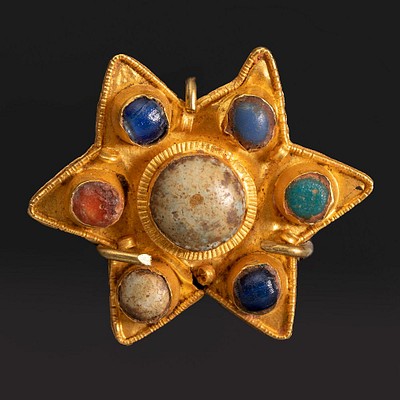ANTONIO DEL CASTILLO Y SAAVEDRA (Córdoba, 1616 - 1668). "Appearance of the Child Jesus to St. Anthony". Oil on canvas. Relined.
Lot 71
About Seller
Setdart Auction House
Carrer Aragó 346
Barcelona
Spain
Setdart Subastas was born in 2004 and is currently the first online art auction in Spain with solidity, prestige and reliability guaranteed by our more than 60,000 users. Setdart has a young, dynamic and enterprising team ready to successfully manage the purchase and sale of art works through custom...Read more
Estimate:
EUR€18,000 - EUR€22,000
$18,750 - $22,916.67
Absentee vs Live bid
Two ways to bid:
- Leave a max absentee bid and the platform will bid on your behalf up to your maximum bid during the live auction.
- Bid live during the auction and your bids will be submitted real-time to the auctioneer.
Bid Increments
| Price | Bid Increment |
|---|---|
| EUR€0 | EUR€10 |
| EUR€200 | EUR€25 |
| EUR€500 | EUR€50 |
| EUR€1,000 | EUR€100 |
| EUR€3,000 | EUR€200 |
| EUR€5,000 | EUR€500 |
| EUR€10,000 | EUR€1,000 |
| EUR€20,000 | EUR€2,000 |
| EUR€50,000 | EUR€5,000 |
About Auction
By Setdart Auction House
Dec 21, 2021
Set Reminder
2021-12-21 07:30:00
2021-12-21 07:30:00
America/New_York
Bidsquare
Bidsquare : Córdoba: 2,000 Years of Art
https://www.bidsquare.com/auctions/setdart-auction-house/c-rdoba-2-000-years-of-art-8049
Setdart Auction House sofia@setdart.com
Setdart Auction House sofia@setdart.com
- Lot Description
ANTONIO DEL CASTILLO Y SAAVEDRA (Córdoba, 1616 - 1668). "Appearance of the Child Jesus to St. Anthony". Oil on canvas. Relined. Measurements: 125 x 103 cm; 150 x 130 cm (frame). In the interior of a room, on a horizontal foreground, appears the Saint of Padua with Franciscan habit seated on a friar's armchair in front of a table-study. On this one, a pen, an inkwell, several books, a note or missive in double sheet, a branch of lilies -allusive to the condition of purity of the Saint- and a skull in diagonal of escape towards the center on a set of three books, two of which present title in their spine. In the upper zone, to the right of a curtain that delimits the room, the Child Jesus descends in full body with the sphere of the world under his left arm, on a throne prepared for him by several little angels in a swirling composition among the vaporousness of the clouds. Below, next to the Saint, two cherubs, one in frontal position and the other in profile, looking upwards, symbolize the arrival of the Child on Earth. Antonio del Castillo y Saavedra was the son of an Extremaduran painter from Llerena, Agustín del Castillo, whose work is little known, but whom Palomino describes as "an excellent painter". He was orphaned in 1626 and was educated by another painter of whom we have no news, Ignacio Aedo Calderón. At an unknown date he may have arrived in Seville -of which there is no effective proof-, where Palomino makes him a pupil of Zurbarán, which has been corroborated in view of the stylistic influence of the master from Extremadura in Castillo's work. In 1635 he was in Cordoba, where he married and settled permanently, becoming without discussion the most important artist of the city. There he produced religious altarpieces as well as portraits and medium-sized series. His work does not show any evolution, and he always kept away from the baroque novelties of other contemporary painters. If in the figures of saints he remains closer to strict naturalism, in the historical productions he tends to be more open, especially because of the ornamentation of architectures and landscapes with which he decorates them. Palomino, already classified among the landscape painters by Lázaro Díaz del Valle, praised his capacity for capturing nature, describing him as "an excellent landscape painter, for which he went out for a few days to walk, with the purpose of drawing, and copied some places from nature". This assertion of the treatise writer is interesting, as it shows Antonio del Castillo to be especially interested in capturing nature, both in landscapes and in everyday characters and animals.
- Shipping Info
-
In-house shipping available. Please inquire at admin@setdart.com.
-
- Buyer's Premium



 EUR
EUR CAD
CAD AUD
AUD GBP
GBP MXN
MXN HKD
HKD CNY
CNY MYR
MYR SEK
SEK SGD
SGD CHF
CHF THB
THB
















